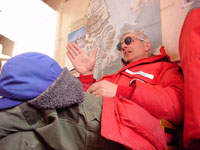|
Penguin
Ranch
p.2
|

|
Emperor
penguins on and under the ice.
by Mary K. Miller
December
15, 2001
Emperors
are also the most accomplished diving birds in the world,
a trait they need to take advantage of the underwater richness
of Antarctica. They can dive under the ice for as long as
22 minutes without surfacing. The deepest dive ever recorded
for an Emperor was 500 meters (1500 feet).
We
got to see some Emperor penguins up close and learn more about
their diving behavior when we visited a sea ice camp called
the "Penguin Ranch." This scientific field camp outside McMurdo
is run by Paul Ponganis, a research biologist from the Scripps
Institute of Oceanography. Dr. Ponganis is also a medical
doctor with a private practice, one of the most unusual dual
careers I've ever run across.
At the Penguin Ranch, there were five penguins living in a
fenced corral with two diving holes carved out of the sea
ice. The penguins were free to dive as much as they wanted
but also seemed quite content to hang out on the ice watching
the group of red-coated people that were also checking them
out. Some of the penguins had devices that looked like jet
packs attached to their backs, either video cameras, depth
recorders, or monitors that recorded the birds’ heart
rates under water.
When
he’s not in Antarctica or studying the diving physiology
of penguins and seals, Dr. Ponganis is an anesthesiologist
for a hospital in San Diego. He told us that the two lines
of work are very complimentary. He uses his medical skills
to anesthetize the birds before he outfits them with their
electronic monitors or cameras. As a doctor, he admires the
penguin’s ability to survive long periods without oxygen,
something that his surgical patients cannot do.
|
|

|

|
Paul
Ponganis in his research hut at
the
Penguin Ranch.
|
|
|
|
From
his work at the Penguin Ranch, Dr. Ponganis has learned that
Emperor penguins can live longer without breathing than people
can because they store more oxygen in their muscles. They
also conserve energy because their streamlined shapes and
powerful wings allow them to swim through the water very efficiently.
Emperor penguins can swim up to 8 miles per hour and will
typically catch five to six fish before surfacing. If need
be, they can even leap out of the water several feet to get
away from the leopard seals or Orca whales that prey on them.
Once
they do surface in the dive hole, we were amazed to hear how
loud the penguins’ exhalations were as they recovered
their breath. We were thrilled to spend some time with penguins
early in our Antarctic expedition. Later this month, we plan
to camp overnight at nearby Cape Royds and talk with some
of the biologists studying Adelie penguins in a breeding colony
there. The penguin population this year is greatly impacted
by the amount of sea ice that has collected behind the giant
iceberg B-15. Because the ice edge is so far away from Royds,
the numbers of breeding penguins are lower this year than
in recent history. How and when they’ll recover is something
we hope to find out from the scientists at Cape Royds.
|

